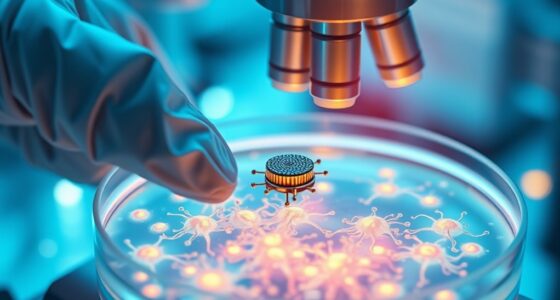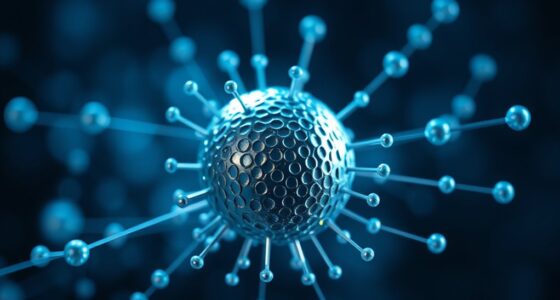Nanomachines in vaccine adjuvants and immune boosters act as tiny delivery systems that target specific immune cells, improving vaccine effectiveness. They can navigate biological barriers, concentrate antigens at the right spot, and control when and where immune activation occurs. This targeted approach enhances immune responses, reduces side effects, and offers safer, more efficient vaccines. If you explore further, you’ll discover how ongoing research is shaping the future of personalized immunizations and global health.
Key Takeaways
- Nanomachines can target specific immune cells, enhancing vaccine delivery and immune activation precisely where needed.
- They serve as advanced adjuvants, amplifying immune responses while reducing side effects and off-target effects.
- Nanomachines enable controlled, sustained release of antigens, improving vaccine efficacy over time.
- Research is advancing multifunctional nanodevices that combine antigen delivery with immune-stimulating adjuvants.
- Targeted nanomachine strategies improve safety, efficacy, and personalized immune responses in vaccine development.
The Role of Nanomachines in Enhancing Vaccine Delivery

Nanomachines play a vital role in improving vaccine delivery by precisely targeting specific cells and tissues. They act as tiny delivery vehicles, steering through the body to reach exact locations, such as immune cells. This precision ensures that the vaccine components are concentrated where they’re needed most, increasing effectiveness while minimizing side effects. Nanomachines can bypass biological barriers, like mucus layers and cell membranes, which often hinder traditional vaccine delivery methods. By controlling release timing and location, they enhance immune response activation. Their small size allows them to circulate efficiently, avoiding rapid clearance. As a result, nanomachines help deliver vaccines more accurately, boosting immune system recognition and response, ultimately leading to more effective immunizations with fewer doses.
Designing Nanomachines for Targeted Immune Activation
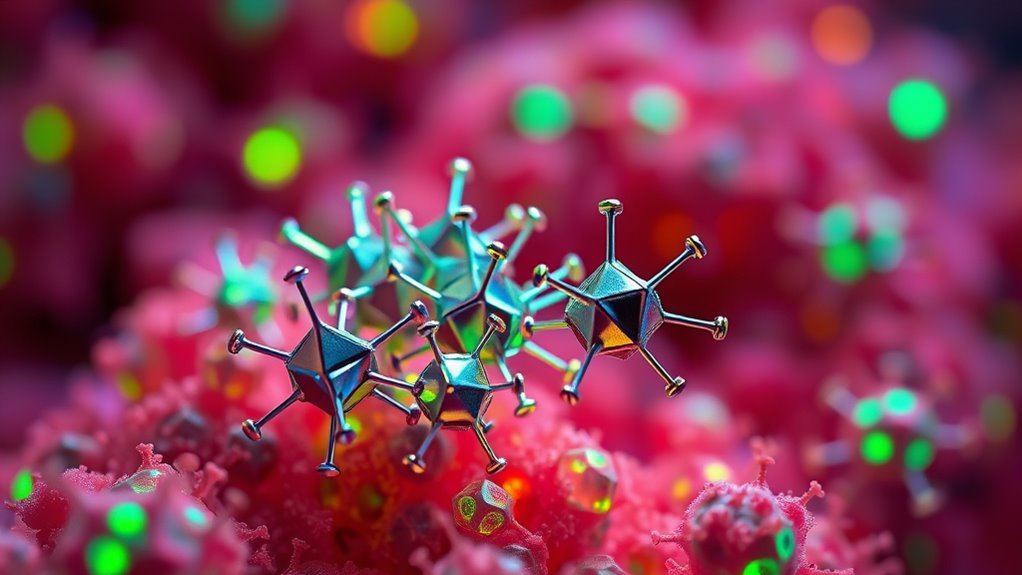
Designing nanomachines for targeted immune activation involves engineering their surfaces to recognize and bind specific immune cells, such as dendritic cells or T lymphocytes. You can achieve this by:
- Attaching ligands or antibodies that target cell-specific receptors
- Modifying surface charge to enhance selective interactions
- Incorporating peptides that mimic natural immune signals
- Fine-tuning nanoparticle size for ideal cellular uptake
- Considering store hours to plan timely administration of vaccines or boosters
These modifications ensure nanomachines deliver their payload precisely where it’s needed, boosting immune responses efficiently. By customizing surface features, you improve specificity, reduce side effects, and promote stronger activation of immune cells. This tailored approach allows for more effective vaccines, leveraging nanotechnology’s precision to stimulate immunity exactly at the desired sites.
Advantages of Nanomachine-Based Adjuvants Over Traditional Methods
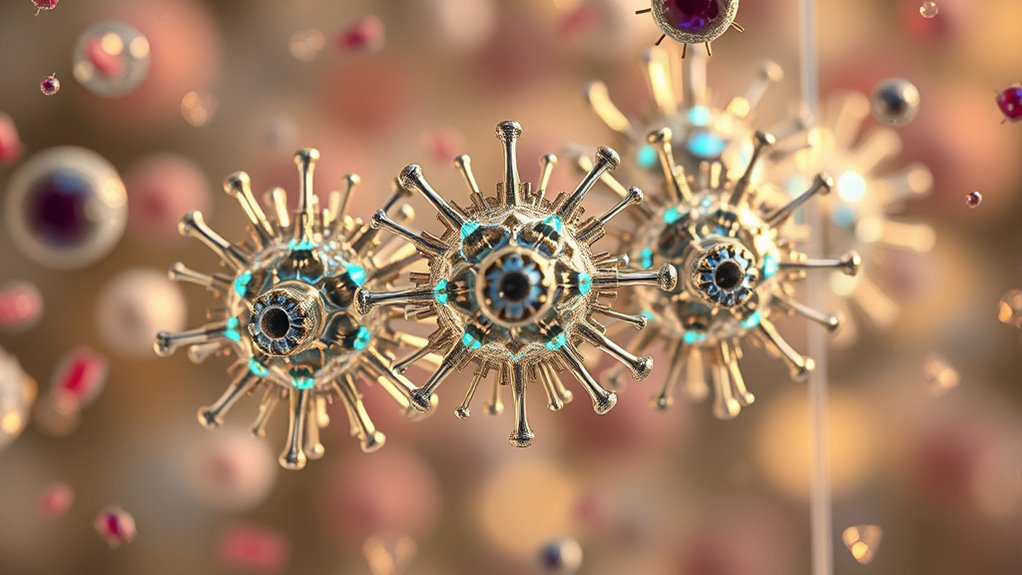
Nanomachine-based adjuvants can trigger a stronger and more precise immune response compared to traditional methods. They deliver vaccines directly to target cells, increasing efficiency and reducing waste. As a result, you may experience fewer side effects while still gaining better protection. Moreover, nanomachines can be engineered to incorporate targeted delivery techniques, further enhancing vaccine efficacy and safety.
Enhanced Immune Activation
Because they can precisely target immune cells, nanomachine-based adjuvants often activate the immune system more effectively than traditional adjuvants. They offer several key advantages:
- Stronger immune responses by delivering antigens directly to immune cells, boosting antibody production.
- Faster reaction times as nanomachines quickly stimulate immune pathways.
- Reduced side effects due to targeted delivery, minimizing unnecessary tissue activation.
- Enhanced memory formation by engaging immune cells more efficiently, leading to longer-lasting immunity.
- The integration of AI in medical technology holds promise for further optimizing nanomachine design and functionality.
These features ensure your immune system responds vigorously and precisely, providing better protection. By focusing activation where it’s needed most, nanomachine-based adjuvants markedly improve vaccine efficacy compared to conventional methods.
Targeted Delivery Efficiency
How do nanomachine-based adjuvants achieve superior targeted delivery compared to traditional methods? They use precise control mechanisms to navigate directly to immune cells, minimizing waste and increasing efficiency. Nanomachines can recognize specific cell markers, releasing antigens exactly where needed. This targeted approach boosts immune responses and reduces off-target effects. The table below highlights key advantages:
| Feature | Traditional Methods | Nanomachine-Based Adjuvants |
|---|---|---|
| Delivery Precision | Less specific | Highly specific targeting |
| Control Over Release | Less controlled | On-demand, controlled release |
| Cell Recognition | Limited | Customizable surface markers |
| Efficiency | Moderate | markedly enhanced |
Additionally, the ability of nanomachines to adapt their surface properties enhances their personality test compatibility with diverse immune cell types, further improving delivery accuracy.
Reduced Side Effects
Thanks to their precise targeting, nanomachine-based adjuvants considerably reduce side effects compared to traditional methods. By delivering the vaccine components directly to immune cells, you minimize exposure to non-target tissues. This targeted approach leads to several benefits:
- Less inflammation and tissue damage at injection sites
- Reduced risk of allergic reactions and adverse immune responses
- Lower chances of systemic side effects like fever and fatigue
- Decreased need for high-dose administrations, minimizing toxicity
– Incorporating advanced composition techniques can further enhance the effectiveness of nanomachine-based adjuvants.
These advantages make nanomachines safer and more tolerable, especially for vulnerable populations. You get effective immune activation without the collateral damage often seen with conventional adjuvants. This precision not only enhances safety but also improves overall patient comfort and compliance.
Current Research and Developments in Nanomachine Vaccines

Recent advancements focus on innovative nanomachine designs that improve vaccine effectiveness. Researchers are now exploring targeted immune activation to enhance precision and reduce side effects. Clinical trials are progressing, bringing these cutting-edge vaccines closer to widespread use. Additionally, the integration of safety and quality considerations ensures that these nanomachine-based vaccines meet rigorous standards for child safety and environmental sustainability.
Nanomachine Design Innovations
Advances in nanomachine design are driving significant breakthroughs in vaccine technology. These innovations focus on enhancing efficiency, stability, and functionality. First, researchers are developing programmable nanomachines that can adapt to different antigens, improving vaccine versatility. Second, biodegradable nanostructures ensure safe breakdown after delivery, reducing side effects. Third, multifunctional nanodevices combine adjuvant properties with antigen delivery in a single platform, boosting immune responses. Fourth, precision assembly techniques allow for custom nanomachine configurations, optimizing targeting and response. Additionally, understanding market research helps tailor nanomachine designs to meet specific healthcare needs. These design innovations enable vaccines to be more effective, safer, and adaptable to emerging diseases. By pushing boundaries in nanomachine architecture, scientists are paving the way for next-generation vaccines that are smarter and more responsive to the immune system’s needs.
Targeted Immune Activation
Nanomachine vaccines are now being engineered to precisely target immune cells, enhancing the specificity and effectiveness of immune responses. These nanodevices can deliver antigens directly to specific immune cell types, reducing side effects and increasing immune activation efficiency. Researchers are developing nanomachines that recognize unique surface markers, ensuring they engage only the intended cells. This targeted approach boosts immune memory and response strength while minimizing off-target effects. The following table highlights key features of current targeted immune activation strategies:
| Strategy | Benefit |
|---|---|
| Surface marker recognition | Precise delivery to specific immune cells |
| Ligand conjugation | Improved binding affinity and specificity |
| Controlled release | Sustained immune stimulation |
| Multivalent targeting | Enhanced immune activation |
| Personalized nanodevices | Tailored responses for individual needs |
Additionally, ongoing research emphasizes the importance of AI safety to ensure that nanomachine vaccines are developed responsibly and securely.
Clinical Trial Progress
Current research efforts have propelled nanomachine vaccines into various stages of clinical trials, demonstrating promising safety and efficacy profiles. You’re likely to find these developments exciting, as they include:
- Multiple Phase I trials confirming safety in healthy volunteers.
- Phase II studies showing strong immune responses and minimal side effects.
- Rapid progression into Phase III, with large-scale testing underway.
- Early indications of effectiveness against target diseases, including emerging pathogens.
These advancements reveal that nanomachine vaccines are gaining regulatory attention and investor interest. As trials progress, you’ll see more data on long-term safety and real-world effectiveness. The ongoing research signals a pivotal shift toward highly targeted, efficient vaccination strategies leveraging nanotechnology. Artificial intelligence’s role in optimizing vaccine design continues to enhance the speed and precision of development processes, promising even more innovative solutions in the near future.
Challenges and Safety Considerations in Nanomachine Applications
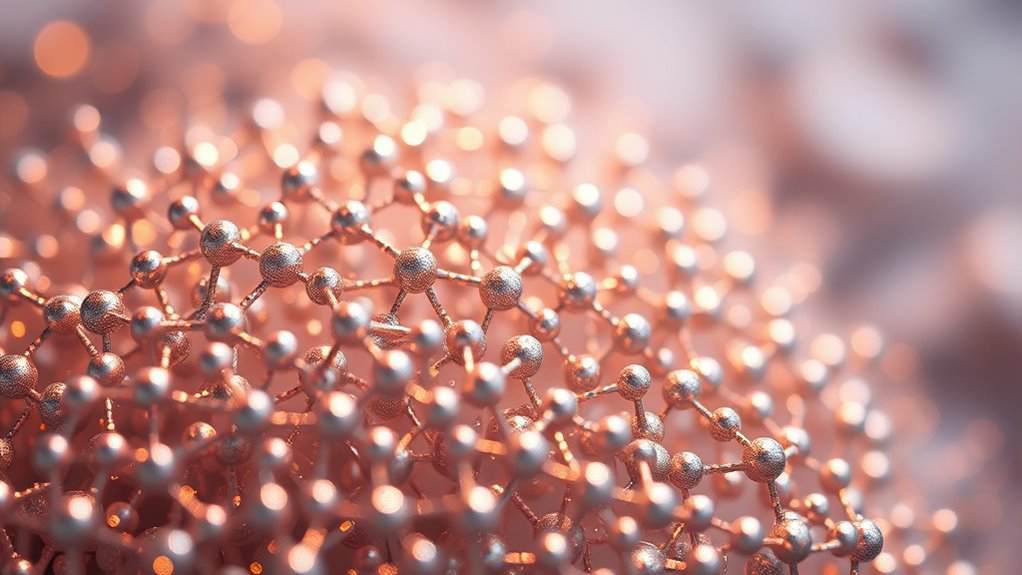
While nanomachines hold great promise for vaccine development, their application also presents significant challenges and safety concerns that must be carefully addressed. You need to take into account potential toxicity, as nanomachines might interact unpredictably with human tissues or trigger immune responses. Ensuring biocompatibility is crucial to prevent adverse effects or long-term accumulation in the body. Manufacturing consistency and scalability pose additional hurdles, as precise control over nanomachine size and function is essential for safety and effectiveness. Regulatory frameworks are still evolving, so you must navigate uncertainties around approval processes. Finally, public perception and ethical considerations demand transparency and thorough risk assessments. Addressing these challenges proactively will be key to safely integrating nanomachines into vaccines and maximizing their immunological benefits. Additionally, understanding the contrast ratio in nanoscale imaging can help optimize the visualization of nanomachine interactions within biological systems.
Future Perspectives and Potential Impact on Global Immunization

Advancements in nanomachine technology have the potential to revolutionize global immunization efforts, making vaccines more targeted, efficient, and adaptable. With these innovations, you could see:
- Tailored vaccines that address specific populations or variants more effectively.
- Faster development and deployment during outbreaks or pandemics.
- Reduced side effects through precision delivery to immune cells.
- Improved access in remote or underserved areas via portable nanomachine-based systems.
These advancements promise to enhance vaccine efficacy and safety, ultimately increasing immunization coverage worldwide. As nanomachines become more sophisticated, they could also enable real-time monitoring of immune responses, helping to optimize vaccination strategies. Overall, the future of nanomachine-driven vaccines points to a more resilient, equitable, and responsive global immunization landscape.
Frequently Asked Questions
How Do Nanomachines Interact With the Human Immune System?
Nanomachines interact with your immune system by targeting specific cells, delivering antigens, or stimulating immune responses directly. They recognize and bind to immune cells, enhancing vaccine effectiveness. You might notice improved protection, as these tiny devices boost your body’s ability to fight infections. Their precise action guarantees that your immune system responds quickly and efficiently, making vaccines safer and more effective through controlled and targeted interactions.
What Materials Are Used to Construct Nanomachines in Vaccines?
You should know that materials like lipids, polymers, and metals are commonly used to build nanomachines in vaccines. Lipids form protective vesicles that deliver antigens efficiently, while polymers provide structural support and controlled release. Some researchers incorporate metals like gold or silica for stability and imaging. These materials are chosen for their biocompatibility, safety, and ability to enhance immune responses, making vaccines more effective and targeted.
Are Nanomachine-Based Vaccines Cost-Effective for Widespread Use?
Nanomachine-based vaccines can be cost-effective for widespread use because they often require fewer doses and can be produced efficiently with scalable manufacturing processes. While initial development might be expensive, mass production can lower costs over time. You might find that their precise targeting and enhanced immune responses reduce overall healthcare costs by preventing diseases more effectively, making them a promising option for large-scale immunization efforts.
How Do Nanomachines Influence Vaccine Stability and Storage?
A stitch in time saves nine, and nanomachines help your vaccines stay potent longer. They enhance stability by protecting the active ingredients from degradation and temperature fluctuations. You’ll find that vaccines with nanomachines necessitate less complex storage conditions, making distribution easier. This innovation ensures your vaccines remain effective during transport and storage, reducing waste and increasing accessibility, especially in remote areas. Ultimately, nanomachines boost vaccine reliability and longevity for better health outcomes.
What Are the Regulatory Hurdles for Approving Nanomachine Vaccines?
You face several regulatory hurdles when approving nanomachine vaccines. Agencies require extensive safety and efficacy data, which means you need rigorous testing and validation. You also must demonstrate consistent manufacturing quality and address potential environmental impacts. Managing evolving regulations for nanotechnology can be complex, requiring you to collaborate closely with authorities. Ultimately, gaining approval demands thorough documentation, transparency, and adherence to strict standards to guarantee public safety and trust.
Conclusion
Imagine nanomachines as tiny architects building bridges between your immune system and pathogens. They revolutionize vaccine delivery, making it more precise and effective. As you embrace these innovations, remember that careful design and safety are your guiding stars. With continued research, nanomachines could become the compass that guides global immunization efforts, transforming vaccines into powerful, targeted shields. The future of medicine is a delicate dance—these tiny machines are leading the way.


